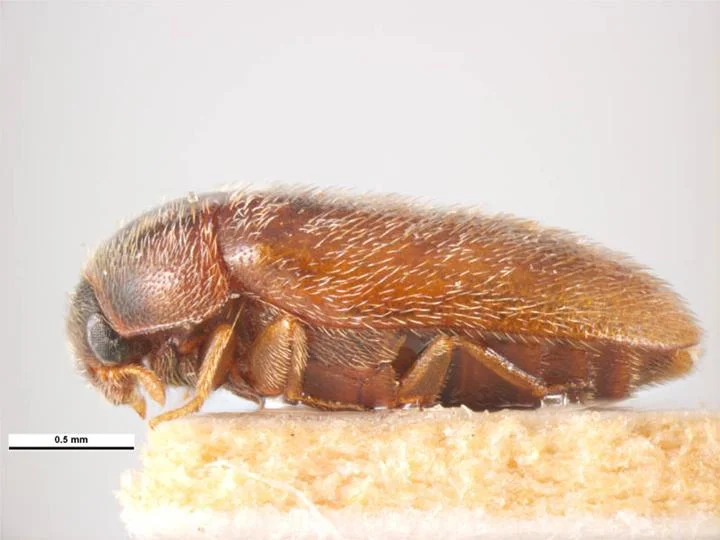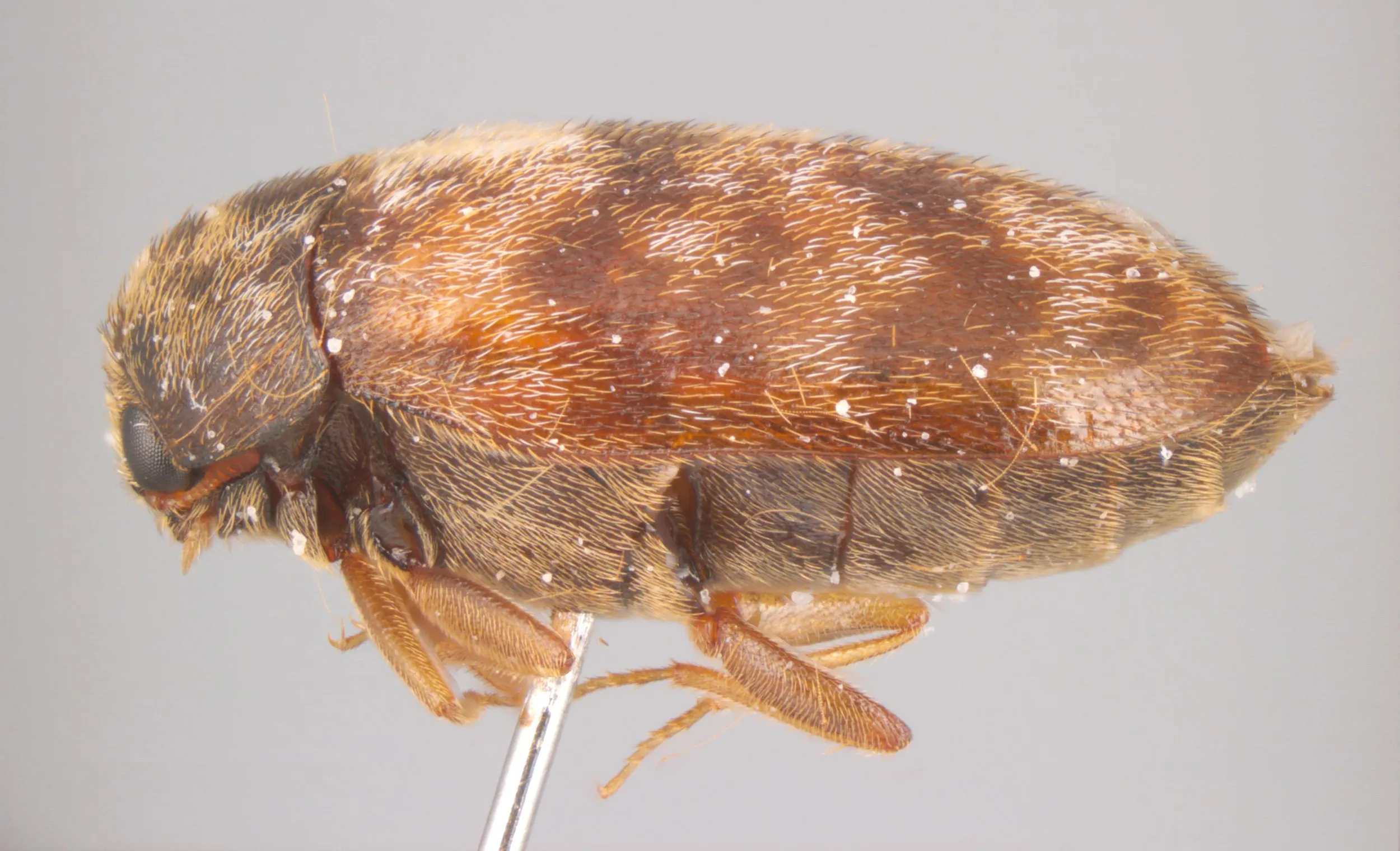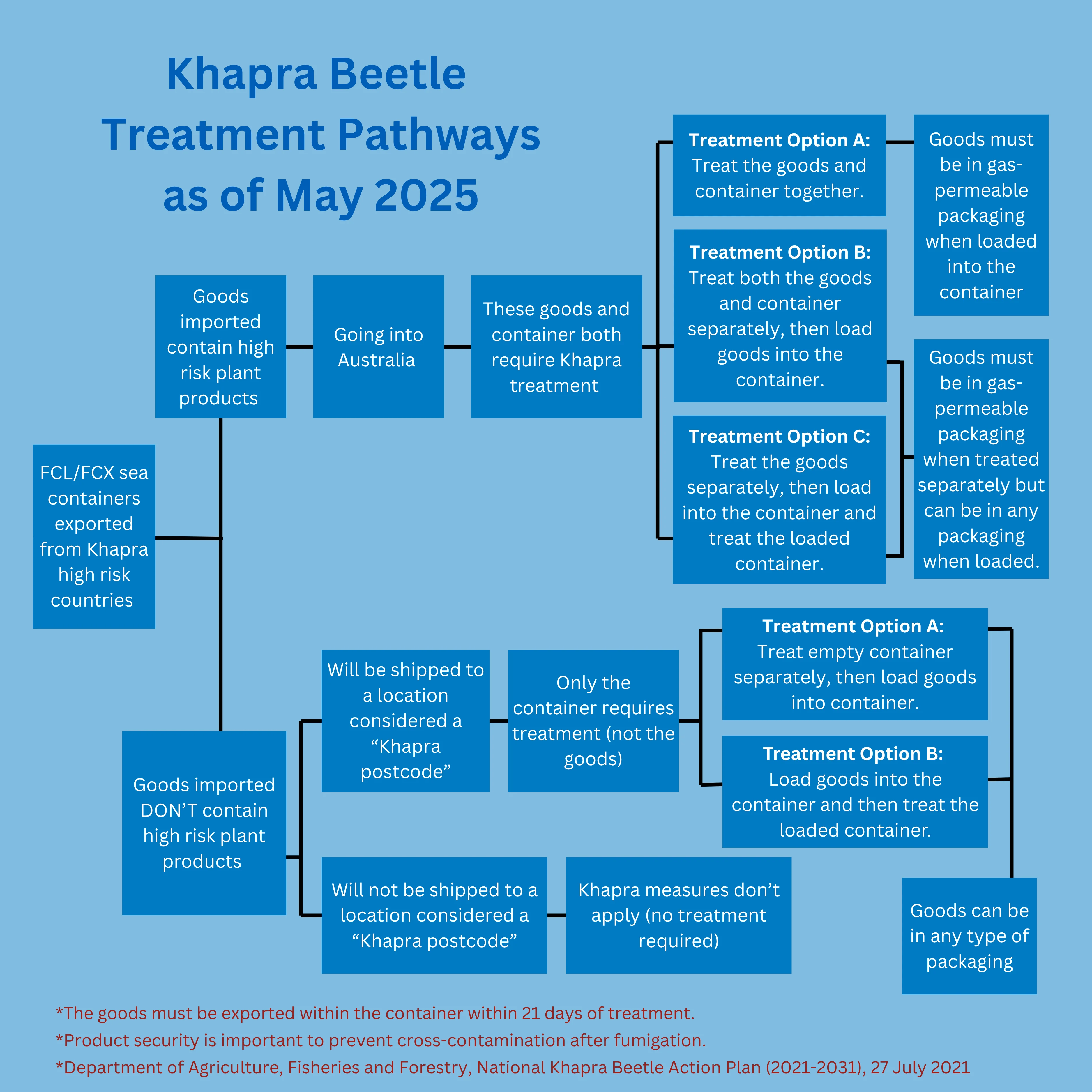- 25 June 2025
101 on Khapra Beetles and importing into Australia
Khapra beetles, scientifically known as Trogoderma granarium, are pests infamous for their impact on stored organic products such as grains and seeds. Their ability to remain undetected for years has allowed them to spread globally, posing significant challenges to agriculture. The beetle's negative effects on both economies and agricultural systems make it a high-risk pest, particularly when importing goods from high-risk countries. This article serves as a guide to understanding the Khapra beetle and offers practical tips on how to prevent its introduction in your future imports.
What is the difference between a Khapra Beetle and a common beetle?
The Khapra Beetle is a small yet highly destructive pest, typically measuring 2 to 5 mm in length. It is distinguishable by its elongated body covered in coarse hairs, usually brown or reddish-brown. Unlike common beetles, which often feed on plants or decaying organic material, the Khapra beetle specifically targets stored food products such as grains and processed foods, posing a severe threat to businesses involved in food storage and transport.
A key difference between the Khapra beetle and common beetles lies in its resilience and lifecycle. Khapra beetles exhibit a rapid lifecycle, with females laying up to 400 eggs during their brief lifespan. The eggs hatch within four days, and the larvae (considered the most damaging stage) can survive on minimal food sources like grains, seeds, and even animal products. This ability to adapt to scarce resources sets them apart from many common beetle species.
Another distinction is their preference for warm, dry conditions, which accelerate their reproduction rates. Infestations can lead to severe losses in stored commodities, with market value reductions of up to 30%. This significantly impacts farmers, food producers, and supply chains, unlike most common beetle infestations, which may not cause such widespread economic disruption.
The difference between a Khapra Beetle and a Warehouse Beetle

Khapra Beetle

Warehouse Beetle
How do Khapra Beetles enter Australia?
The Khapra beetle typically enters Australia via shipping containers used to transport food products such as grains. Its ability to hide in cracks, crevices and grooves within the containers enables it to remain undetected for extended periods (can be years). Under ideal conditions, the beetle reproduces rapidly, resulting in severe consequences, including the contamination of goods.
How does this impact you?
Shipping lines lease their containers to various providers, which means that even if your shipment doesn’t include organic materials, it could still be at risk. Khapra beetles can hide in containers for years, undetected. For example, if you’re shipping machinery in a container that was previously used to transport grains, there’s a chance your shipment could become contaminated. This contamination can lead to delays and additional inspection requirements.
High risk countries of Khapra Beetles
The Khapra beetle has been detected in over 43 countries, with the majority of interceptions originating from India, Saudi Arabia, Pakistan, and Iran. The Department of Agriculture, Water and the Environment enforces strict import regulations for all countries, with even stricter conditions applied to those with high populations of Khapra beetles.
Below is a regional breakdown of countries where the pest has been recorded:
Asia
Afghanistan, Bangladesh, Bhutan, China, India, Indonesia, Iran, Iraq, Israel, Japan, Jordan, Kazakhstan, Kyrgyzstan, Kuwait, Lebanon, Malaysia, Myanmar, Nepal, North Korea, Oman, Pakistan, Palestine, Philippines, Qatar, Saudi Arabia, South Korea, Sri Lanka, Syria, Taiwan, Tajikistan, Thailand, Turkey, Turkmenistan, United Arab Emirates, Uzbekistan, Vietnam, Yemen.
Africa
Algeria, Angola, Benin, Botswana, Burkina Faso, Burundi, Cameroon, Central African Republic, Chad, Comoros, Congo, Democratic Republic of the Congo, Djibouti, Egypt, Equatorial Guinea, Eritrea, Eswatini, Ethiopia, Gabon, Gambia, Ghana, Guinea, Guinea-Bissau, Ivory Coast, Kenya, Lesotho, Liberia, Libya, Madagascar, Malawi, Mali, Mauritania, Morocco, Mozambique, Namibia, Niger, Nigeria, Rwanda, Senegal, Sierra Leone, Somalia, South Africa, South Sudan, Sudan, Tanzania, Togo, Tunisia, Uganda, Zambia, Zimbabwe.
Europe
Albania, Armenia, Azerbaijan, Bosnia and Herzegovina, Bulgaria, Croatia, Cyprus, Georgia, Greece, Hungary, Italy, Kosovo, Malta, Moldova, Montenegro, North Macedonia, Portugal, Romania, Russia, Serbia, Slovakia, Slovenia, Spain, Ukraine.
Americas
Khapra beetles are occasionally detected in shipments due to indirect shipping routes; however, established populations are rare.
Oceania
New Zealand has recorded interceptions, but no established populations have been found.
What measures are place to protect Australia from Khapra Beetles?
The Department of Agriculture, Water and the Environment established the National Khapra Beetle Action Plan (2021-2031) in order to protect Australia from the risk to fauna and flora posed by the pest. The plan focuses on prevention, detection and response actions.
The plan establishes the following:
-
Prevention methods: Australia has implemented strict measures to prevent the Khapra beetle from entering the country. These include mandatory offshore treatments and detailed inspections for containers from high-risk regions, along with prohibitions on importing specific high-risk products, especially through vulnerable pathways like personal shipments, international mail and low-value freight. The country’s Cargo Compliance Verification Program ensures routine inspections of shipments, even those considered low-risk, to catch threats early
-
Advanced Detection Techniques: Detecting Khapra beetles has become faster and more accurate thanks to advanced methods like PCR-based testing, which identifies the pest with high precision. Australia is also at the forefront of innovation, using the world’s first environmental DNA (eDNA) surveys specifically for shipping containers. This groundbreaking method can identify traces of Khapra beetles early, significantly increasing the chances of stopping infestations before they spread. Surveillance is focused on high-risk areas such as ports, warehouses, and specialised import facilities. These targeted inspections play a critical role in quickly identifying and managing potential infestations, helping to protect Australia’s biosecurity.
-
Effective Response Strategies: When the pest is detected, it is important that response is quick and effective. Australia utilises advanced tracing systems to monitor the movement of potentially infested containers and goods, ensuring risks are promptly contained and addressed. Australia utilises eradication techniques which include heat treatments, precise applications of the insecticide deltamethrin, and environmentally friendly fumigants, which serve as safer and reliable alternatives to older methods like methyl bromide. Dedicated Incident Management Teams are deployed immediately after detection to execute these measures efficiently, preventing the beetle from establishing itself in the country.
Since 2020, these proactive efforts have led to a steady decline in Khapra beetle detections.

High Risk Products
-
Bean seed (Phaseolus spp.)
-
Celery seed (Apium graveolens)
-
Chickpeas (Cicer arietinum)
-
Coriander seed (Coriandrum sativum)
-
Cucurbit seed (Cucurbita, Cucumis, Citrullus spp.)
-
Cumin seed (Cuminum cyminum)
-
Dried chillies/capsicum (Capsicum spp.)
-
Faba bean, broad bean, fava bean (Vicia faba)
-
Fennel seed (Foeniculum vulgare)
-
Lentils (Lens culinaris)
-
Mung beans, cowpeas (Vigna spp.)
-
Pea seed (Pisum sativum)
-
Peanuts (Arachis hypogaea)
-
Pigeon Pea seed (Cajanus cajan)
-
Rice (Oryza sativa)
-
Safflower seed (Carthamus tinctorius)
-
Soybean (Glycine max)
-
Wheat seed (Triticum spp.)
How Mainfreight can help?
Mainfreight can assist customers in navigating the Australian government’s strict prevention strategies for shipments. With our extensive international network, we can advise treatment providers for fumigation services to ensure compliance before shipments arrive in Australia. Additionally, we provide guidance throughout the process, helping to simplify the requirements and ensure a smooth, hassle-free experience for our customers.
Learn more about our biosecurity and customs services
Find out how Mainfreight can help solve your importing and exporting needs.
Find Out More